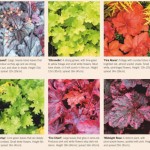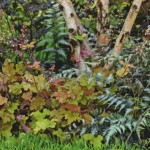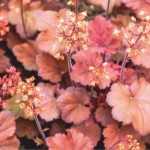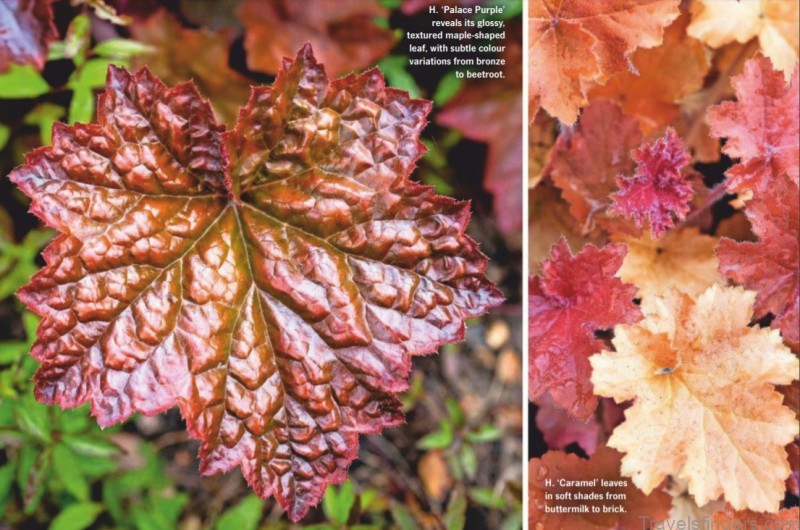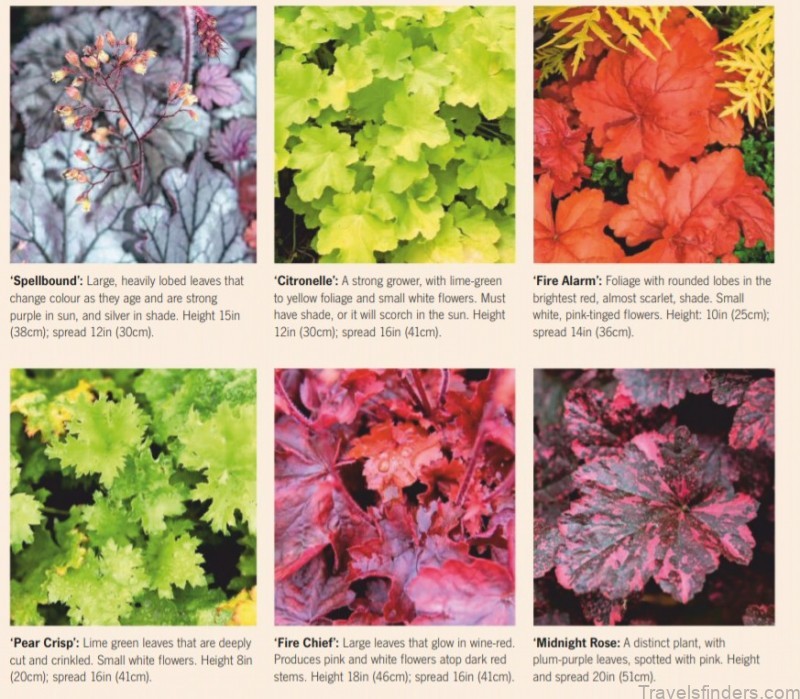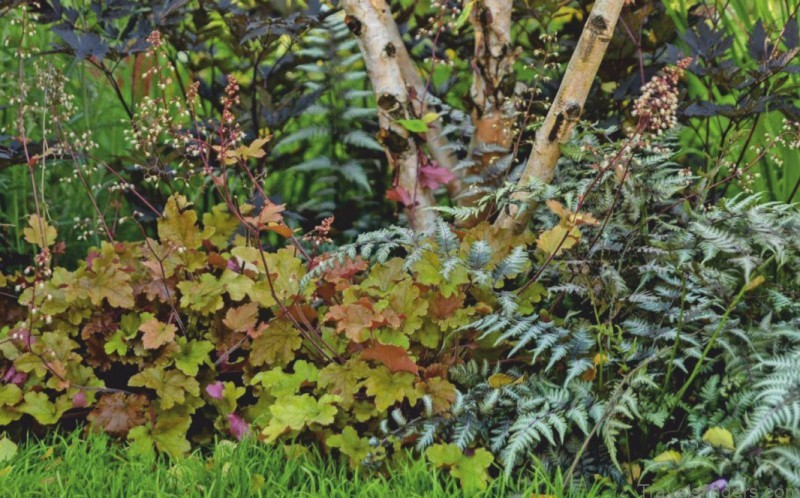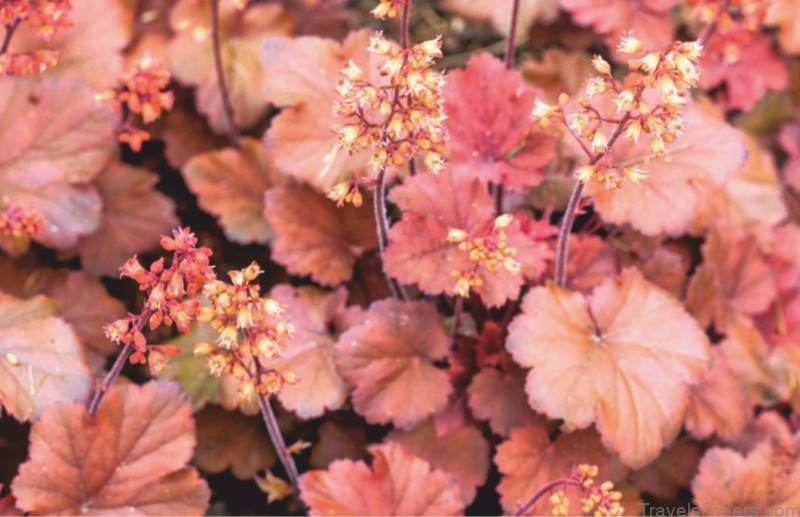AS SUMMER LOOSENS its grip on the garden, and autumn starts to hold sway, changes emerge. Flowers last a little longer in the cooler days, and each one is especially appreciated. More noticeable are the colours of leaves as they lose their greenness and develop the unmistakable shades of the new season, as golds, bronzes, oranges and reds slowly spread across the garden. Heucheras are foliage plants supreme; their dazzling leaves look entirely at home in the autumn landscape. But they have been infusing borders and pots with vibrant colour all year, from the moment their fresh leaves unfurl, as a background to their often entrancing flowers. And they will continue to earn their keep well into the winter, when the garden is otherwise stripped of all its gloss.
The possibilities for garden combinations are infinite with the current range of heucheras, from combining similar colours, to contrast with other plants, to collecting the brightest varieties and creating areas of colour to rival any summer bedding display. Also known as coral bells, heucheras are hardy herbaceous perennials, but, unlike most, they have woody stems that rise above the surface as they grow. Their leaves are remarkably diverse, in shape as well as colour, but they could generally be considered maple-like. They usually have five lobes, but they can be rounded or have sharp points; some with hairy edges or undulated and crisped. They are evergreen, but the foliage is at its most lush in spring and summer, when it is fresh. Leaves can be up to 5in (13cm) across or just 2in (5cm) in the latest miniatures. Although most heuchera species have plain green leaves, the range of colours now includes bright yellow, red and purple, and spotted with pink, brown and orange, and overlaid with grey and silver.
PAINTED BY NATURE : With their vibrant and varied leaves, heucheras extend colour in borders throughout autumn and beyond Photo Gallery
Dainty blooms
The flowers of most species are small and white, but pink and red were common among early green-leaved hybrids, and more colour has been introduced into modern ones with colourful leaves, so now flowers can be red, pink, white and yellow. Heucheras bloom in late spring and early summer. The flowers are carried in feathery clusters on thin, tall, wiry stems. While they have a few small leaves at the base, the stems are otherwise leafless, so the flowers, although small, are quite showy. When the flowers are over, the stems should be cut off to keep the plants tidy. In many dark-leaved cultivars, the flowers are small, with tiny white petals. In others, which have H. sanguinea in their ancestry, the petals are coloured and more showy, as in modern cultivars, such as the City Series and the Soda Series: ‘Paris’ has deep pink flowers above green leaves; ‘Tokyo’ has red flowers above lime green foliage; and ‘Cherry Cola’ has tangerine blooms above rusty-red leaves.
The flowers have no scent, but are loved by bees, which will visit the blooms throughout the flowering period.
Colourful history
Heucheras come from America, where they grow in shady and often rocky places, in surprisingly little soil with perfect drainage. A century ago, they were grown and bred exclusively for their flowers, and H. sanguinea, which has unusually large, red flowers, and the H. brizoides, which is a hybrid between H. sanguinea x H. micrantha, were the focus of attention. Heuchera micrantha is found wild along the Pacific states and H. sanguinea in upland areas of Arizona and New Mexico.
The first serious work on breeding heucheras was carried out in Norfolk by Alan Bloom, who sowed thousands of seeds to produce cultivars that were grown for their flowers. Although his attention soon turned to breeding colourful garden plants rather than cut flowers, and his early hybrids are rarely seen today, ‘Bressingham Hybrids’ are still seen for sale, the result of the work he started almost a century ago. Other species include H. americana, from central and eastern USA and Canada. This variety is resistant to mildew and useful in breeding. While the purple-flushed and silver-mottled plant called ‘Dale’s Strain’ held promise for breeders, it was ‘Palace Purple’, discovered in 1980, in the Kew Palace gardens, that provided the impetus.
It quickly became popular for the intensity of its beetroot-red leaves. Since its introduction, breeders have exploited the potential of the species, and there are now hundreds of cultivars. Probably the biggest impact was made by Dan Heims, of Terra Nova Nurseries of Oregon USA, and despite their increasingly complex and colourful range of hybrids, some of their early cultivars have stood the test of time, such as black ‘Obsidian’ and ‘Green Spice’, with its dark-veined, green leaves. Many fine and commonly grown cultivars have also been produced in northern France by Thierry Delabroye, using the large-leaved H. villosa from the south-east USA. His large, strong-growing cultivars include the brown ‘Caramel’.
Heucheras vary in height and spread, from just 8in (20cm) to 12in (30cm) high and 20in (51cm) or more across for the largest varieties, and taller when in bloom. They are clump-forming, so are easy to combine with other plants and will not spread. They are ideal for smaller gardens, looking good all year and not leaving unsightly gaps in winter. As the older leaves die, leaving a central tuft of younger leaves, they do reduce in size slightly, but the compensation for this is the burst of vibrant new growth the following spring. A tidy in the spring, removing old leaves and flower stems when they have faded, is all the regular attention they should require. After two years, most will need dividing and replanting. Growing conditions Heucheras are hardy, although their foliage can become battered and less attractive in windswept areas, and in especially cold winters. In common with most perennials, they prefer a well-drained soil that is moist in summer. Once established, they are surprisingly resistant to drought, and they prefer a rather dry soil over a waterlogged site. Heucheras will grow in soil over a wide pH range, but they do prefer slightly acidic conditions and may struggle on clay over chalk. Clay soils should be improved with the addition of organic matter or grit.
They are popular plants for containers and can be grown in regular multipurpose compost, although the addition of some loam, by mixing this with equal parts John Innes No 3 compost, will encourage better growth. They will need repotting in approximately two years. Heucheras cope well with sun or part shade. The darker-leaved cultivars develop their best colouring in bright light and are at their best in a position where they receive sun for at least half the day. The paler and yellow-leaved kinds are valuable for brightening shady sites. In general, sunnier planting areas produce more compact plants and brighter colours, and will flower more freely, while plants grown in shade will have a looser habit. Unlike hostas, with which they are so effectively planted, heucheras are not targeted by slugs and snails, and apart from occasional mildew, disease is not an issue. Aphids may attack the flower stems, but are not really a problem.
Unfortunately, there is one major pest: the vine weevil. These long-snouted beetles lay eggs in compost, and their grubs devour the roots of plants. Although they attack a wide range of plants, including primulas, fuchsias and begonias, they have a special liking for heucheras, and they will eat all the roots from plants until only the stem is left, and the plants lose most of their foliage. With care, plants can often be saved by replanting the remaining parts. Those in pots are particularly vulnerable, especially if grown in multipurpose compost, which is soft and easy for the vine weevil to lay its eggs in.
Those planted in the border often survive mild attacks, but will grow more slowly. Planting partners Heucheras are adaptable, and with such a wide range of colours, there are almost infinite planting possibilities. Their mounded, neat habit makes them perfect for containers, and they can be planted at any time of year to combine with temporary partners for summer, autumn, winter and spring. They are especially useful for autumn-planted pots, baskets and window boxes, where they can be combined with violas, small evergreen shrubs, spring flowering bulbs and evergreen grasses and sedges.
In the summer, when their colouring is at its brightest, heucheras can hold their own against vibrant bedding plants, such as petunias, coleus, marigolds and diascias. When the season comes to a close, these bedding plants can be removed and replacements planted for spring colour. In the garden, heucheras are suitable for the front of borders, in larger rock gardens and as edging. They are perfect partners for ornamental grasses, for ferns and hostas, but they are shown off to best advantage when planted as a mixed group to accentuate the extraordinary diversity of their colours.
Heucheras have changed more than most other garden plants in the past few decades, creating exciting possibilities for the gardener. Their foliage provides colours never seen in hardy garden plants before; as bright as most garden flowers. In addition, their small blooms are excellent nectar sources for honeybees and bumblebees, making them valuable for wildlife too. Whether a few are planted as accents to duller foliage or collected to create an explosion of colour, they will bring interest to any garden throughout the whole year.


